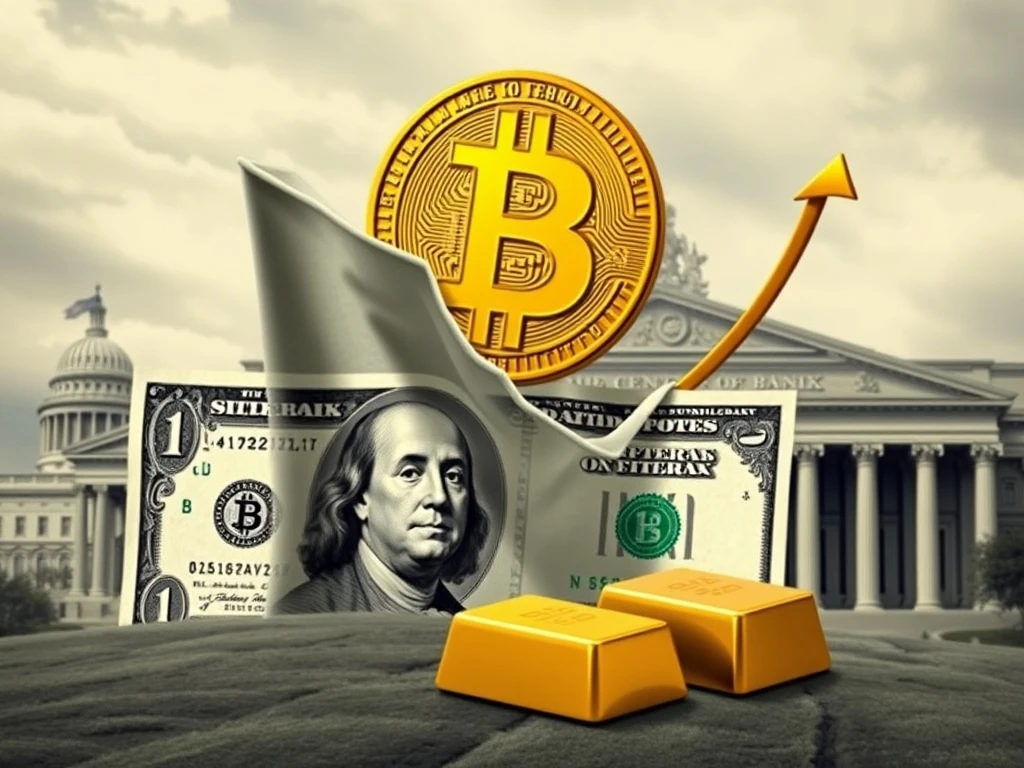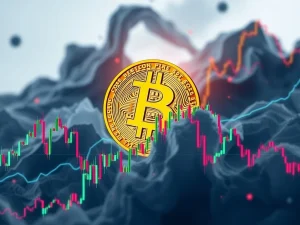Bitcoin’s Ascendant Role: Financial Institutions Embrace the Debasement Trade

The financial world is undergoing a profound shift. Specifically, a growing number of financial institutions now openly discuss the ‘debasement trade.’ This strategy, long championed by crypto enthusiasts and gold investors, recognizes a critical economic reality. It suggests that traditional fiat currencies will lose purchasing power over time. Consequently, assets like Bitcoin and gold are gaining significant traction. This shift marks a pivotal moment for global finance, reflecting a deep concern about monetary policy.
Understanding the Debasement Trade Phenomenon
What exactly is the debasement trade? It represents an investment strategy. Investors anticipate a decline in the value of fiat currencies. Central banks’ expansive monetary policies often cause this devaluation. They print more money, which increases supply. As a result, the existing currency’s value diminishes. This phenomenon drives investors towards alternative assets. These assets are expected to maintain or increase their value. Gold and Bitcoin are prime examples of such assets. Historically, gold has served as a reliable store of value. Now, Bitcoin emerges as a digital alternative. Both assets offer a hedge against inflation and currency debasement. This strategy directly counters the effects of government spending and debt accumulation.
Anthony Pompliano, a well-known entrepreneur, highlighted this trend recently. He noted that institutions now cling to this concept. It provides them with a perceived layer of protection. For years, Bitcoiners and goldbugs articulated this exact concern. They consistently warned about endless money printing. Now, mainstream finance acknowledges this reality. Pompliano states, “This now feels like there is no longer a debate about this.” Many experts agree. They see trouble ahead for the US dollar and traditional bonds. Therefore, Bitcoin and gold are benefiting significantly.
Why Financial Institutions are Shifting to Bitcoin and Gold
The recognition of the debasement trade is accelerating. Several fundamental reasons drive this trend. Firstly, government deficits continue to mount. National debts reach unprecedented levels globally. Secondly, accommodative monetary policies suppress real yields. This means investors earn very little from traditional savings. Brian Cubellis, Onramp Bitcoin’s chief strategy officer, emphasizes these points. He comments, “Recognition of the ‘debasement trade’ is accelerating for a simple reason: deficits mount, debt stacks higher, and accommodative policy suppresses real yields.”
Investors seek a stable benchmark. They want assets that resist dilution. This search naturally leads them to gold and Bitcoin. Jeff Park, ProCap BTC chief investment officer, expressed his satisfaction. He stated, “We’ve been wanting to see private wealth management and financial advisers come to embrace Bitcoin as an allocation [in portfolios].” This indicates a growing acceptance. Institutional investors are starting to integrate these assets. They see them as crucial components of a diversified portfolio. This shift represents a maturation of the cryptocurrency market. It also reflects a renewed appreciation for precious metals.
The ‘Dark Matter of Finance’: Debasement Trade’s Impact
Matt Hougan, Bitwise chief investment officer, offers a compelling analogy. He describes the debasement trade as the “dark matter of finance.” This comparison is apt. “You can’t quite touch it, but it affects everything,” he explains. This invisible force influences global markets. It shapes investment decisions across the board. The implications are far-reaching. It impacts everything from individual savings to national economic strategies. The effects are subtle yet pervasive. Investors must understand this underlying current. It dictates much of the financial landscape.
This widespread recognition of debasement fears fuels the ongoing crypto rally. Data from Bloomberg supports this observation. 
Bitcoin: The Anti-Debasement Asset
Many view Bitcoin as simply “digital gold.” However, its properties go beyond this comparison. Enrique Ho, CFO of Blink Wallet, clarified this on X. He stated, “It is anti-debasement by design.” Bitcoin possesses unique characteristics. These features make it particularly resilient against currency devaluation. Key attributes include:
- Fixed Supply: Bitcoin has a hard cap of 21 million coins. No more will ever be created.
- Transparent Issuance: New Bitcoins enter circulation at a predictable rate. This rate halves approximately every four years.
- Trustless Verification: Its decentralized network verifies all transactions. No central authority controls it.
These design principles ensure its scarcity. They also guarantee its predictable monetary policy. Ho emphasized, “It was the purest expression of capital preservation in a world where money itself is being repriced.” This makes Bitcoin a powerful tool. It allows individuals and institutions to preserve capital. It protects against the erosion of purchasing power. The current environment highlights Bitcoin’s value proposition. It truly stands apart from traditional fiat currencies.
The Weakening US Dollar and Its Implications
Evidence of the US dollar debasement is clear. The US Dollar Index (DXY) tracks the greenback’s performance. It measures the dollar against a basket of major currencies. The DXY has experienced a significant decline. It fell by approximately 12% this year. The index dropped from a high of 110 in January. It reached a three-year low of 96.3 in mid-September. While it recovered slightly in October, the long-term trend remains downward. 
Gold’s Resurgence in a Debased Environment
While Bitcoin captures headlines, gold also plays a vital role. It has historically been a safe haven asset. Its performance this year reinforces its status. Gold has gained 50% so far this year. This significant appreciation demonstrates its effectiveness. It acts as a hedge against currency debasement. Many investors view gold as a traditional store of value. It offers stability during economic uncertainty. As the US dollar weakens, gold’s appeal grows. It provides a tangible asset. This asset holds value independently of government policy. Both gold and Bitcoin represent different facets of the same strategy. They offer protection in an environment of increasing monetary expansion. Their combined strength creates a formidable defense for portfolios.
Navigating the Future: Portfolio Strategy and the Debasement Trade
The ‘debasement trade’ will likely define the next decade. This is not merely a short-term trend. It represents a fundamental shift in economic thinking. Financial institutions are adapting their strategies. They are incorporating assets like Bitcoin and gold. This move reflects a proactive approach. They aim to protect client wealth against future inflation. Investors should consider how this trend impacts their portfolios. Diversification becomes more critical than ever. Holding a mix of traditional and alternative assets can mitigate risk. It also positions portfolios for potential growth. The traditional 60/40 portfolio (60% stocks, 40% bonds) may no longer be optimal. Bonds, in particular, face challenges. Suppressed real yields diminish their attractiveness.
The evolving landscape demands new perspectives. Understanding central bank policies is crucial. Monitoring the US dollar index provides valuable insights. Furthermore, staying informed about cryptocurrency developments is essential. The integration of digital assets into mainstream finance is accelerating. This creates new opportunities. It also presents new challenges. Investors must educate themselves. They need to understand the unique risks and rewards. The debasement trade is no longer theoretical. It is a tangible force. It reshapes investment decisions globally. Embracing this reality is key to future financial success. This shift ensures robust portfolio performance in an uncertain economic future.
Long-Term Implications for Global Finance
The long-term implications of the debasement trade are profound. It signals a potential re-evaluation of national currencies. Trust in central bank policies may diminish further. This could lead to a more diversified global reserve system. Assets like gold and Bitcoin could play larger roles. Nations might increasingly seek alternatives to the US dollar. This would reduce the dollar’s dominance. Such a shift would have massive geopolitical and economic consequences. It could reshape trade relationships. It might also alter global power dynamics. The current environment is a precursor to these larger changes. The financial world stands at a crossroads. The choices made today will determine the landscape for decades. The debasement trade is more than just an investment strategy. It is a commentary on the state of global monetary policy. It highlights the urgent need for sound money principles. This is a crucial conversation for all stakeholders.










